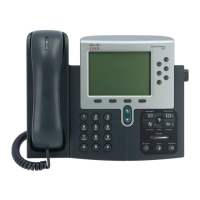1-14
Cisco Unified IP Phone Administration Guide for Cisco Unified Communications Manager 7.1
OL-18913-01
Chapter 1 An Overview of the Cisco Unified IP Phone
Understanding Security Features for Cisco Unified IP Phones
Table 1-4 Overview of Security Features
Feature Description
Image authentication Signed binary files (with the extension .sbn) prevent tampering with the
firmware image before it is loaded on a phone. Tampering with the image causes
a phone to fail the authentication process and reject the new image.
Customer-site certificate installation Each Cisco Unified IP Phone requires a unique certificate for device
authentication. Phones include a manufacturing installed certificate (MIC), but
for additional security, you can specify in Cisco Unified Communications
Manager Administration that a certificate be installed by using the Certificate
Authority Proxy Function (CAPF). Alternatively, you can install a Locally
Significant Certificate (LSC) from the Security Configuration menu on the
phone. See the “Configuring Security on the Cisco Unified IP Phone” section on
page 3-13 for more information.
Device authentication Occurs between the Cisco Unified Communications Manager server and the
phone when each entity accepts the certificate of the other entity. Determines
whether a secure connection between the phone and a Cisco Unified
Communications Manager should occur; and, if necessary, creates a secure
signaling path between the entities by using TLS protocol. Cisco Unified
Communications Manager will not register phones unless they can be
authenticated by the Cisco Unified Communications Manager.
File authentication Validates digitally signed files that the phone downloads. The phone validates
the signature to make sure that file tampering did not occur after the file creation.
Files that fail authentication are not written to Flash memory on the phone. The
phone rejects such files without further processing.
Signaling Authentication Uses the TLS protocol to validate that no tampering has occurred to signaling
packets during transmission.
Manufacturing installed certificate Each Cisco Unified IP Phone contains a unique manufacturing installed
certificate (MIC), which is used for device authentication. The MIC is a
permanent unique proof of identity for the phone, and allows Cisco Unified
Communications Manager to authenticate the phone.
Secure SRST reference
(SCCP phones only)
After you configure a SRST reference for security and then reset the dependent
devices in Cisco Unified Communications Manager Administration, the TFTP
server adds the SRST certificate to the phone cnf.xml file and sends the file to
the phone. A secure phone then uses a TLS connection to interact with the
SRST-enabled router.
Media encryption Uses SRTP to ensure that the media streams between supported devices proves
secure and that only the intended device receives and reads the data. Includes
creating a media master key pair for the devices, delivering the keys to the
devices, and securing the delivery of the keys while the keys are in transport.
Signaling encryption
(SCCP phones only)
Ensures that all SCCP signaling messages that are sent between the device and
the Cisco Unified Communications Manager server are encrypted.
CAPF (Certificate Authority Proxy
Function)
Implements parts of the certificate generation procedure that are too
processing-intensive for the phone, and interacts with the phone for key
generation and certificate installation. The CAPF can be configured to request
certificates from customer-specified certificate authorities on behalf of the
phone, or it can be configured to generate certificates locally.

